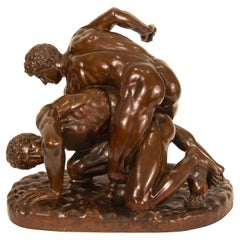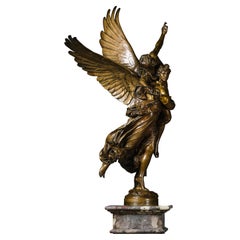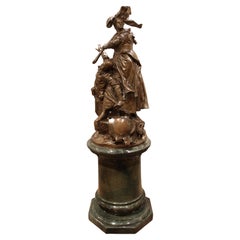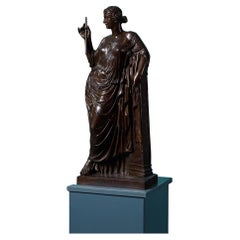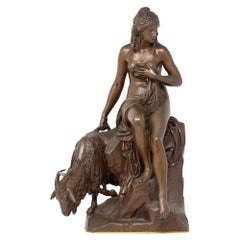Metal Figurative Sculptures
27
to
1
16
11
27
27
27
4
2
1
1
27
Height
to
Width
to
27
26
3
2
2
27
25
2
68
109
74
57
41
Material: Metal
Creator: Ferdinand Barbedienne
Large Grand Tour Sculpture Bronze Greco-Roman Uffizi Wrestlers Barbedienne
Located in Rochester, NY
Grand Tour circa 1860s bronze of the Wrestlers. Rich fine dark brown patina. Marked "F. Barbedienne Fondeur." The Wrestlers also known as The Two Wrestlers, The Uffizi Wrestlers or The Pancrastinae...
Category
19th Century Italian Grand Tour Antique Metal Figurative Sculptures
Materials
Bronze
Ferdinand Barbedienne " Diana" Sculpture, 19th Century
Located in Madrid, ES
"Diane de Gabies"
French sculpture, late 19th century.
Patinated bronze with "Ferdinand Barbedienne" foundry marks.
Height: 51 cm.
Very good condition.
Category
19th Century French Baroque Antique Metal Figurative Sculptures
Materials
Bronze
‘Gloria Victis’, A Patinated Bronze Figural Group by Mercié, Cast by Barbedienne
Located in Brighton, West Sussex
A Patinated Bronze Figural Group of ‘Gloria Victis’ (‘Glory to the Vanquished’), Cast by Ferdinand Barbedienne from the Model by Marius-Jean-Antonin Mercié (French, 1845-1916).
‘Gloria Victis’ (‘Glory to the Vanquished’).
Bronze, gilt and dark brown patina.
Signed 'A. Mercié', with foundry inscription 'F. BARBEDIENNE, Fondeur. Paris.' and A. Collas reduction cachet. The integral base titled 'GLORIA VICTIS'.
This cast is part of a limited edition by the Barbedienne Foundry.
France. Circa 1880.
‘Gloria Victis’ is one of the most recognisable and important works of sculpture of the nineteenth century and a definitive image of France’s historic national identity. The figure of glory, winged and wearing armour, carries a dying young warrior heavenwards towards fame and immortality. The compositional daring of the group must be admired for balancing two figures on the minimal support of one foot, wings spread in the moment before taking flight.
Mercié was a student at the French Academy of Rome when the Prussians invaded France in 1870. Shortly after the war had begun, he executed a group depicting the figure of Fame supporting a victorious soldier. When news reached Mercié in Rome that the French had surrendered, he decided to alter his group, replacing the victorious soldier with a defeated casualty, thus transforming an allegory of ‘Glory to the Victors’ into one of ‘Glory to the Vanquished’. Completed in 1872, a year after the defeat of French soldiers against the Prussian army, the statue personifies a defeated but heroic France. The title is also a reversal of the famous formula, ‘Vae Victis’ (Death to the Vanquished), which the Gallic general Brennus exclaimed upon defeating the Romans in 390 BC. The figure of the fallen soldier was thought to represent Henri Regnault, a fellow sculptor of Mercié who was killed on the last day of fighting.
Measuring 317 cm. high the original group of ‘Gloria Victis’ was unveiled in plaster at the Salon of 1872. It was bought by the City of Paris for the sum of twelve thousand francs and then cast in bronze by Victor Thiébaut for eight thousand five hundred francs. The bronze was exhibited at the Salon in 1875 and first placed in Montholon Square in the 8th arrondissement. In 1884 it was transferred to the courtyard of the Hôtel de Ville and in 1930, it entered the collection of the Musée du Petit Palais, where it can be seen to this day.
The Thiébaut Frères foundry also cast Gloria Victis bronzes for the cities of Niort (requested 1881) Bordeaux (requested 1883), Châlons-sur-Marne (today, Châlons-en-Champagne; requested 1890), and Cholet (requested 1901). In 1905, the Danish brewer and art collector Carl Jacobsen was permitted to have an exact cast made of the original sculpture in Paris, on condition that the base was made 2 cm lower and bore the inscription “Original tilhører Paris By” (The original belongs to the City of Paris). It too was cast by the Thiébaut Frères foundry. Gloria Victis was one of Jacobsen’s most important and his last acquisition. Today it has been returned to its original position in the Winter Garden at Glyptoteket, Copenhagen, Denmark.
The full-size plaster was shown again at the Paris Expositon universelle of 1878 alongside a bronze reduction by Barbedienne. By this time Antonin Mercié had entered into a commercial edition contract with the Ferdinand Babedienne foundry to produce bronze reductions of Gloria Victis, his most famous work. Gloria Victis is first recorded to have been produced in three sizes and by 1886 Barbedienne’s ‘Catalogue des Bronzes D’Art’ lists six sizes measuring 3/5, 9/20, 7/20, 3/10, 6/25 and 2/10, of the original. These reductions were produced by an invention of Barbedienne’s business partner Achille Collas. The Collas reducing machine was a type of complex mechanical pantograph lathe that enabled sculpture to be mathematically measured and transcribed to scale, in the round, thus making a reduced size plaster from which a bronze could be cast.
Mercié's modern sculpture had become an instant classic, even receiving an entry in the Nouveau Larousse Illustré. The success of the group undoubtedly lay in the fact that it was admired not just on an aesthetic level, but also on a patriotic level, particularly in its commemoration of heroism in defeat. Immediately ‘Gloria Victis’ was recognised as a national artwork, capable of arousing patriotism and casts were ordered from Barbedienne as local memorials commemorating the war’s dead for cities across France. ‘Gloria Victis’ was considered so much a part of France’s national identity that for the 1900 Paris Exhibition, Ferdinand Barbedienne’s nephew Gustave Leblanc, loaned a bronze example to feature as part of l’Exposition centennale de l’art français.
Literature:
For an interesting account of the process of creating a reduction in bronze of the Gloria Victis by Barbedienne and illustrations of the casting and finishing of the bronze see:
'Ferdinand Barbedienne': Theodore Child; Harper's new monthly magazine, Volume 73, Issue 436, September 1886.
‘Contemporary French Sculptors’: The Century, Volume 33, Issue 3, Jan 1887.
‘Modern French Sculpture’: Harper's new monthly magazine, Volume 76, Issue 452,
January 1888.
S, Lami, ‘Dictionnaire des sculpteurs de l'Ecole française au dix-neuvième siècle’, Tome III. G.-M., Paris, 1914, p. 432.
Peter Fusco and H.W. Janson, The Romantics to Rodin: French Nineteenth Century Sculpture from North...
Category
19th Century French Antique Metal Figurative Sculptures
Materials
Bronze
French Marble and Bronze Inkwell Signed Ferdinand Barbedienne, Paris, circa 1870
Located in Milan, IT
A Verona red marble remarkable inkwell, pure Empire style representing a gilded bronze of the bust of Antinous as Dioniso. Empire style, Generous size, excellent state of preservatio...
Category
1860s French Empire Antique Metal Figurative Sculptures
Materials
Marble, Bronze
Large French Patinated Bronze Sculpture of David by Mercié and Barbedienne
Located in London, GB
Large French patinated bronze sculpture of David by Mercié and Barbedienne
French, circa 1878
Measures: Height 77cm, width 36cm, depth 27cm...
Category
Late 19th Century French Renaissance Antique Metal Figurative Sculptures
Materials
Bronze
Exceptional 19th Century Bronze Entitled ““Quand Meme” by Mercié and Barbedienne
Located in New York, NY
A Large and Exceptional Late 19th Century Patinated Bronze Figural Group Entitled “Quand Meme” by Mercié and Barbedienne on Pedestal
Marius-Jean-Antonin Me...
Category
Late 19th Century French Belle Époque Antique Metal Figurative Sculptures
Materials
Bronze
French 19th Century Patinated Bronze Statue Signed P. Dubois And F. Barbedienne
Located in West Palm Beach, FL
An exceptional French 19th century patinated bronze statue signed P. Dubois and F. Barbedienne. The statue entitled Le Courage Militaire, is raise...
Category
19th Century French Antique Metal Figurative Sculptures
Materials
Bronze
French 19th Century Patinated Bronze Statue of Laocoön and His Sons
Located in West Palm Beach, FL
A most impressive and high quality French 19th century patinated bronze statue of Laocoön and his sons, signed Barbedienne. The bronze is raised b...
Category
19th Century French Antique Metal Figurative Sculptures
Materials
Bronze
French 19th Century Bronze Statue of Venus, Signed Barbedienne
Located in West Palm Beach, FL
A classical and most elegant French 19th century patinated bronze statue of kneeling Venus, signed F. Barbedienne Fondeur and stamped "Reduction Mecaniq...
Category
19th Century French Antique Metal Figurative Sculptures
Materials
Bronze
French 19th Century Louis XVI Bronze Statue of the 'Allegorie de L'Histoire'
Located in West Palm Beach, FL
A beautiful French 19th century Louis XVI st. patinated bronze and ormolu statue of the 'Allégorie de l'Histoire' by Georges Bareau and F. Barbedienne. This "Symbol of History" statu...
Category
19th Century French Louis XVI Antique Metal Figurative Sculptures
Materials
Bronze, Ormolu
Italian 19th Century Bronze Statue of Apollo, Signed F. Barbedienne Fondeur
Located in West Palm Beach, FL
A handsome and high-quality Italian 19th century patinated bronze statue of Apollo, signed F. Barbedienne, Fondeur. The statue is raised by a circular base with a finely detailed tre...
Category
19th Century Italian Antique Metal Figurative Sculptures
Materials
Bronze
Set of Four Spelter Plaques by Ferdinand Barbedienne
Located in London, GB
Set of four spelter plaques by Ferdinand Barbedienne
French, late 19th century
Measures: Height 45cm, width 12cm, depth 0.5 cm
This set of four pla...
Category
Late 19th Century French Neoclassical Antique Metal Figurative Sculptures
Materials
Spelter
Four Antique Bronze Plaques Depicting Water-Nymphs, by Ferdinand Barbedienne
Located in London, GB
Four antique bronze plaques depicting water-nymphs, by Ferdinand Barbedienne
French, 19th century.
Measures: Height 47cm, width 12cm, depth 2.5cm
Finely cast in relief from patinated bronze with parcel gilt patina, these French 19th Century panels each depict a Classical female water-nymph. The relief structure and design is after four panels from the important marble fountain from the Renaissance period in Paris called the Fontaine des Innocents. This was created by the French sculptor Jean Goujon...
Category
19th Century French Renaissance Antique Metal Figurative Sculptures
Materials
Bronze
French 19th Century Ormolu, Bronze, and Marble Statue on Original Pedestal
Located in West Palm Beach, FL
A stunning museum quality French 19th century ormolu, patinated bronze, Rouge Griotte, Coquillier de Bilbao, and Sarrancolin marble statue and original pedestal named "Gloria Victus...
Category
19th Century French Antique Metal Figurative Sculptures
Materials
Marble, Bronze, Ormolu
French Mid-19th Century Louis XVI Style Patinated Bronze Statue
Located in West Palm Beach, FL
A sensational and large scale French mid 19th century Louis XVI st. patinated bronze statue of Diana the Huntress, signed by Barbedienne. Diana dressed in classical attire and is rea...
Category
19th Century French Louis XVI Antique Metal Figurative Sculptures
Materials
Bronze
Ferdinand Barbedienne Bronze Sculpture of Diana of Gabii
Located in Kastrup, DK
Ferdinand Barbedienne 1810-1892.
A brown patinated bronze statuette after the antique of "Diana of Gabii"
Signed F. Barbedienne. Barbedienne foundry m...
Category
19th Century French Neoclassical Revival Antique Metal Figurative Sculptures
Materials
Bronze
Antique Patinated Bronze Sculpture of Diana by Ferdinand Barbedienne
Located in London, GB
Antique Patinated Bronze Sculpture of Diana by Ferdinand Barbedienne
French, late 19th Century
Dimensions: Height 60cm, width 22cm, depth 22cm
This...
Category
Late 19th Century French Neoclassical Antique Metal Figurative Sculptures
Materials
Bronze
Mid-19th Century French Bronze Figure of the Borghese Gladiator
Located in London, GB
A French bronze figure of the Borghese Gladiator, mid-19th century, cast by Ferdinand Barbedienne, after the antique.
Base dimensions: 34.5cm...
Category
Mid-19th Century French Classical Roman Antique Metal Figurative Sculptures
Materials
Bronze
"Florentine Singer" Bronze Sculpture by P. Dubois and F. Barbedienne, Circa 1880
Located in PARIS, FR
Signed P. Dubois 1865 and F. Barbedienne fondeur
Stamped with réduction mécanique Collas
A patinated bronze « Florentine Singer » sculpture, inspir...
Category
1880s French Antique Metal Figurative Sculptures
Materials
Bronze
Ferdinand Barbedienne Bronze Boy & Goose Sculpture 19th Century
Located in Bishop's Stortford, Hertfordshire
A finely patinated French antique bronze by Ferdinand Barbedienne portraying a a young boy caressing a large goose. The figure is mounted on an angled and shaped base and is signed '...
Category
19th Century French Napoleon III Antique Metal Figurative Sculptures
Materials
Bronze
Antique Bronze Statue of Arlequin by René de Saint-Marceaux
Located in London, GB
A bronze Statuette of Arlequin
by Charles-René de Paul de Saint-Marceaux
Cast by Barbedienne. The mischievous Harlequin, arms crossed in contemplation, wearing a grin and a mask, tr...
Category
1880s French Belle Époque Antique Metal Figurative Sculptures
Materials
Bronze
'The Soldier of Marathon' Bronze after a Model by Cortot Cast by Barbedienne
By Ferdinand Barbedienne, Jean Pierre Cortot
Located in Brighton, West Sussex
'The Soldier of Marathon' - A large patinated bronze group after a model by Jean-Pierre Cortot, Cast by Ferdinand Barbedienne.
Jean-Pierre Cort...
Category
Late 19th Century French Antique Metal Figurative Sculptures
Materials
Bronze
Patinated Bronze Sculpture by Denys-Pierre Puech, Signed 19th Century
Located in New York, NY
Denys-pierre Puech
French, 1854-1942
La Sirene
Signed ‘D.PUECH’; inscribed F. BARBEDIENNE, Fondeur
Patinated Bronze circa 19th century
Foundry Cast: Ferdinand Barbedienne
37 1/2 in. x 27 in. x 16 in
Notes: Puech conceived the idea for ‘La Sirene’ during his stay at the Villa Medici when he fell passionately in love with the celebrated opera singer Emma Calvé, who was then performing in Rome. Peuch wrote, "it is to her that I owe the inspiration for the group." The sculpture shows a winged chimeric siren with a tail of a fish abducting a Ephebus. Puech noted the rarity of the scene of a woman abducting a man, rather than the more common depiction of a man carrying away a female victim. Peuch says, “I had the presentiment that, with the Siren's rape of the Ephebus, I could express the force of passion, which reached towards the unknown, which, itself, might be fidelity or the fall..." In Greek mythology the sirens seduced sailors with their singing only to lead them to their death in the sea.
Literature: Denys Puech...
Category
Late 19th Century French Antique Metal Figurative Sculptures
Materials
Bronze
19th Century Patinated Bronze Sculpture of a Dancer Zingara by F. Barbedienne
Located in New York, NY
A finely casted patinated bronze sculpture of a dancer Zingara after a model by Jean-Baptiste Clésinger by F. Barbedienne foundry. Modeled dancing with a tambourine, inscribed F. BAR...
Category
19th Century French Antique Metal Figurative Sculptures
Materials
Bronze
Antique Gilt Bronze Mantel Clock by Sevin and Barbedienne
Located in London, GB
This ormolu clock is an exemplary work by the famous French 19th century metalworker and foundry-owner, Ferdiand Barbedienne. Working with a design made by the acclaimed onamentalist, Louis-Constant...
Category
Late 19th Century French Neoclassical Antique Metal Figurative Sculptures
Materials
Ormolu, Bronze
'La Jeunesse' 19th Century bronze sculpture by Chapu and Barbedienne
Located in London, GB
This fine and exceptionally cast patinated bronze sculpture is the work of two masters of the decorative arts, Henri Chapu (French, 1833-1891) and Ferdinand Barbedienne (French, 1810-1892). Chapu was responsible for the design of the sculpture which is titled 'La Jeunesse' and depicts a young girl swathed in Classical style clothing reaching up to place a laurel branch on top of a wall.
The original work was crafted in white marble as part of a monument to Henri Regnault...
Category
19th Century French Neoclassical Antique Metal Figurative Sculptures
Materials
Bronze
Classical Style Bronze Sculpture of Penelope by Cavelier and Barbedienne
Located in London, GB
This large patinated bronze antique sculpture depicts the Classical figure Penelope, the wife of Odysseus (Roman name Ulysses) who appears in ...
Category
Late 19th Century French Neoclassical Revival Antique Metal Figurative Sculptures
Materials
Bronze
Related Items
F. Barbedienne Large Bronze Sculpture of Euterpe
Located in Wormelow, Herefordshire
A bronze sculpture of Euterpe attributed to French metalworker Ferdinand Barbedienne (1810-1892). Embellished to the reverse with the official stamp of the Collas et Barbedienne foun...
Category
Mid-19th Century French Neoclassical Antique Metal Figurative Sculptures
Materials
Bronze
Large, Decorative Bronze Sculpture of a Spartan Warrior with Sword, Greco Roman
Located in Berlin, DE
Large and decorative bronze sculpture of a Spartan warrior.
By Professor Victor Heinrich Seifert. Signed.
Excellent masterpiece. On marble base.
Category
19th Century Austrian Antique Metal Figurative Sculptures
Materials
Bronze
Free Shipping
H 24.02 in W 9.65 in D 5.52 in
Jean-Baptiste Auguste Clesinger, French Bronze Bust of Jesus Christ, Barbedienne
Located in New York, NY
An exceptional French patinated realistic miniature bronze bust of Jesus Christ, 1858
Signed: J CLESINGER. 1858 and F. BARBEDIENNE FONDEUR, wi...
Category
19th Century French Antique Metal Figurative Sculptures
Materials
Bronze
H 6.5 in W 3.5 in D 2.5 in
Gilt and Patinated Bronze Ewer on Stand, Attributed to Barbedienne
Located in London, GB
The exceptional bronze casting, in stunningly intricate detail, on this beautiful sculptural piece has been attributed to master metalworker Ferdinand Barbedienne. The piece takes th...
Category
Late 19th Century French Neoclassical Antique Metal Figurative Sculptures
Materials
Ormolu, Bronze
Fine French Patinated Bronze Figural Group Titled Pro Patria by Edouard Drouot
Located in Los Angeles, CA
A very fine French antique patinated bronze figural group titled Pro Patria by Edouard Drouot
(French, 1859-1945) late 19th century.
Depicting a figure of winged Victory with a ...
Category
Late 19th Century French Late Victorian Antique Metal Figurative Sculptures
Materials
Bronze
H 30 in W 18 in D 9 in
Edouard Henri Delesalle Bronze Venus De Milo Grand Tour Bronze Sculpture
Located in Atlanta, GA
Edouard Henri Delesalle (French, 1823-1851), circa 1840.
A good quality Grand Tour model of Venus de Milo cast in bronze.
"Venus de Milo or Aphrodite of Melos is an ancient Greek ...
Category
19th Century French Grand Tour Antique Metal Figurative Sculptures
Materials
Bronze
H 10.625 in W 3.375 in D 2.75 in
"Menelaeus" Grand Tour Bronze Sculpture
Located in West Palm Beach, FL
Antique late 19c "Menelaeus" sculpture Grand Tour bronze from a Palm Beach estate
Menalaeus was the husband of Helen of Troy and the original of this sculpture in white marble res...
Category
Late 19th Century Italian Grand Tour Antique Metal Figurative Sculptures
Materials
Bronze
19th Century Demosthenes Bronze Sculpture by Barbedienne Foundry
Located in 263-0031, JP
A bronze figure representing Demosthenes (384-322 BC), a Greek statesman and orator. The sculpture is based on a Roman copy of an original Greek statue. The chocolate-brown patina of...
Category
19th Century French Neoclassical Antique Metal Figurative Sculptures
Materials
Bronze
No Reserve
H 15.95 in W 5.91 in D 4.14 in
Grand Tour Bronze Sculpture of Spinario the Thorn Picker
Located in Philadelphia, PA
A grand tour bronze sculpture of Spinario.
Measures: Height: circa 8 1/4 in.
Items purchased from David Sterner Antiques must delight you....
Category
Early 20th Century Italian Grand Tour Metal Figurative Sculptures
Materials
Bronze
Grand Tour Bronze Statue of Narcissus
Located in Stockton, NJ
A 19th century Grand Tour bronze statue of Narcissus. Foundry mark Sommer Napoli engraved on circular plinth. Includes original Victorian er...
Category
19th Century Italian Grand Tour Antique Metal Figurative Sculptures
Materials
Bronze
Ferdinand Barbedienne, A French Ormolu and Champleve Enamel Jardiniere, C. 1870
Located in New York, NY
Ferdinand Barbedienne, A French Ormolu and Champleve Enamel Jardiniere, C. 1870, The Design Attributed to Louis Constant Sevin.
An exceptional qualit...
Category
19th Century French Napoleon III Antique Metal Figurative Sculptures
Materials
Bronze, Enamel, Ormolu
Pair of Gilt and Patinated Bronze Candelabra by Ferdinand Barbedienne
Located in Brighton, West Sussex
A Pair of Gilt and Patinated Bronze Figural Five-Light Candelabra Cast by Barbedienne after the Models by Alexandre Falguière and Paul Dubois.
Signed ‘FALGUIERE’ and ‘P. DUBOIS’ ...
Category
19th Century French Antique Metal Figurative Sculptures
Materials
Bronze
H 41.34 in W 11.03 in D 11.03 in
Previously Available Items
French Bronze Amalthea and Jupiter's Goat Barbedienne
Located in Newark, England
The Bronze beautifully cast after the original by Pierre Julien (1731-1804) named “Amalthée et la chèvre de Jupiter” was executed by the renowned Ferdinand Barbedienne foundry durin...
Category
Late 19th Century French Art Nouveau Antique Metal Figurative Sculptures
Materials
Bronze, Ormolu
Barbedienne 'Dying Slave' After Michelangelo Grand Tour Cast Bronze Sculpture
By Ferdinand Barbedienne, Michelangelo
Located in New York, NY
Monumental sized 'Dying Slave' sculpture after the original by Michelangelo at the Louvre Museum in Paris, cast by Barbedienne as a showpiece of their craft, with outdoor patina and ...
Category
1880s French Grand Tour Antique Metal Figurative Sculptures
Materials
Bronze
H 36 in W 12 in D 10 in
P. Dubois & Barbedienne 'Florentine Singer' French Romantic Period Cast Bronze
Located in New York, NY
Paul Dubois (French 1829 –1905) 'Florentine Singer' French Romantic period cast bronze sculpture, after the original by Dubois in 1865, mechanical re...
Category
Late 19th Century French Romantic Antique Metal Figurative Sculptures
Materials
Bronze
Pair of French 19th Century Neoclassical Style Bronze and Ormolu Statues
Located in West Palm Beach, FL
An impressive and high quality true pair of French 19th century Neo-Classical st. patinated bronze and ormolu statues of Moses and the Seated Thinker, signed F. Barbedienne, Fondeur....
Category
19th Century French Neoclassical Antique Metal Figurative Sculptures
Materials
Bronze, Ormolu
H 9.5 in W 4.25 in D 4.75 in
Bronze Hand of Grand Duchess Maria Pavlovna of Russia, by F. Barbedienne
Located in West Palm Beach, FL
Bronze Hand of Grand Duchess Maria Pavlovna of Russia, by F. Barbedienne
Exquisite bronze model of the hand of Grand Duchess Maria Pavlovna of Russia (1786-1859) of the Romanov family...
Category
19th Century French Antique Metal Figurative Sculptures
Materials
Bronze
Antique French Bronze Sculpture “Joan of Arc” after Henri Chapu by Bar
Located in Shippensburg, PA
During the last quarter of the 19th century, a broad movement of Romanticism artists were putting forth works of historical "celebrities", a topic that deeply resounded with sentiments of the time. When Chapu completed this work, originally in marble, he exhibited it at a highly opportune moment on the eve of the disastrous Franco-Prussian war, a moment of flagging morale when France was greatly in need of a heroine of her proportions to rescue the flagging morale. She was an almost immediate success, Chapu's first great triumph, and was first exhibited in sculpted marble at Salon in 1872, this original is held at the Musee du Luxembourg.
Later being offered by the F. Barbedienne foundry, most of these editions retailed between the years of 1875-1890, they offered several edition sizes: 117 cm, 72 cm, 60 cm, 47 cm, 36 cm, 30 cm and 23 cm. An 1872 example founded by F. Barbedienne in the 117 cm edition is held at the Musee des Beaux-Arts de Bordeaux.
The present example is a finished in a lovely brown patina, preserved under wax and clearly in outstanding condition. She is of utmost precision, every line and detail flawlessly chased and filed with great skill, the result being an inspiring portrayal of Joan of Arc. She is depicted as a simple shepherdess of a Lorraine village, her hands clasped in prayer as she firmly looks into the horizon, facing her destiny with a resolute strength. She believed that during these prayers she received the instruction to save France, at the time swallowed in The Hundred Years War. As she sits in repose on the naturalistic base, supported by nothing and in what should likely be a somewhat uncomfortable pose, she is relaxed and at ease with herself, in this, Chapu displays a mastery of the human figure that few of his school could command. The work is signed along the edge "Chapu" and along the back "F. Barbedienne Fondeur" with the seal of credit to the A. Collas mechanism for reduction.
Born in Le Mee (Seine-et-Marne) in September of 1833, Henri Michel Antoine Chapu...
Category
19th Century French Romantic Antique Metal Figurative Sculptures
Materials
Bronze
Classical Patinated Bronze Sculpture of Diana by Ferdinand Barbedienne
Located in London, GB
Classical patinated bronze sculpture of Diana by Ferdinand Barbedienne
French, late 19th century
Dimensions: Height 60cm, width 40cm, depth 28cm
...
Category
Late 19th Century French Classical Roman Antique Metal Figurative Sculptures
Materials
Bronze
H 23.63 in W 15.75 in D 11.03 in
"Allegory of History" French Bronze Sculpture by Georges Bareau and Barbedienne
Located in Shippensburg, PA
A fine little antique cabinet bronze sculpture by Georges Marie Valentin Bareau, it tells the story of the annals of history as they are recorde...
Category
Late 19th Century French Antique Metal Figurative Sculptures
Materials
Bronze
H 10 in W 9 in L 10 in
Ferdinand Barbedienne '1810-1892' French Bronze Sculpture Boy with Goose
Located in Bishop's Stortford, Hertfordshire
A finely patinated French antique bronze by Ferdinand Barbedienne (1810-1892) portraying a a young boy caressing a large goose dating from the 19th Century. The figure is mounted on ...
Category
Mid-19th Century European Romantic Antique Metal Figurative Sculptures
Materials
Bronze
Free Shipping
H 7.09 in W 5.32 in D 3.55 in
F. Barbedienne, a Life-Size Silvered Bronze of King Henri IV Enfant as a Child
By Ferdinand Barbedienne, Baron François Joseph Bosio
Located in New York, NY
Ferdinand Barbedienne, A life-size silvered bronze sculpture of King Henri IV Enfant As a Child, after Francois-Joseph Bosio, (French, 1768 - ...
Category
19th Century French Antique Metal Figurative Sculptures
Materials
Bronze
H 49 in W 18 in D 15 in
Neapolitan Fisherboy Playing with a Turtle after François Rude
By Francois Rude, Ferdinand Barbedienne
Located in Paris, FR
Mid-19th century bronze sculpture with brown patina featuring a cheerful Neapolitan boy playing with a tortoise by the sea. Cast by Ferdinand Barbedienne after François Rude...
Category
19th Century French Romantic Antique Metal Figurative Sculptures
Materials
Bronze
'David Vainqueur de Goliath' a Bronze Figure by Antonin Mercié, circa 1880
Located in Brighton, West Sussex
'David Vainqueur de Goliath' - A fine Patinated bronze figure by Antonin Mercié, cast Ferdinand Barbedienne.
French, circa 1880.
Rich brown patiantion with gold highlights, the base cast with a lozenge with the Hebrew for David and the base with a roundel for Réduction mécanique Collas.
The figure depicts the Biblical story of young David's final triumph over Goliath and is one of the most recognisable and celebrated sculptures of the nineteenth century.
Influenced by the works of Verrocchio and Donatello, the piece earned Mercié a first class medal as well as the rank of Chevalier de légion d'honneur at the Paris Salon of 1872.
The life-size version of Mercié's David is in the permanent collection of the Museé D'Orsay (RF 186, LUX 74).
Marius-Jean-Antonin Mercié (1845- 1916) was born in Toulouse and studied at the École des Beaux Arts, Paris, under Alexandre Falguière and François Jouffroy, He made his debut at the Salon in 1868 when he won the celebrated Grand Prix de Rome with the group 'Thesée vainqueur du Minotaure'. This entitled him to study in Rome, and whilst studying in Rome from 1869 to 1873, he already executed the models for his first two popular works, 'David' and 'Gloria Victis'.
In 1870 whilst Mercié was still in Italy, the Prussians invaded France and he began, somewhat prematurely, modelling Gloria Victis to commemorate his country’s imminent victory. Unfortunately the victory never came and Mercié re-modelled his sculpture replacing the victorious soldier with one of defeat thereby transforming an allegory of ‘Glory to the Victors’ into one of ‘Glory to the Vanquished’. The model for the wounded soldier was reputably based on his friend and fellow sculptor Henri Regnault who was killed on the last day of the war. The full-size plaster model of Gloria Victis was exhibited at the Salon of 1874, winning the Medaille d'Honneur and critical acclaim. It was then purchased by the City of Paris for the sum of twelve thousand francs and cast in bronze by Victor Thiébaut for a further eight thousand francs. The original bronze is now placed in the central courtyard of the Paris Hôtel de Ville. The plaster version was re-exhibited at the Paris Universal Exhibition of 1878, alongside bronze reductions of the group by Barbedienne.
After Mercié completed the plaster model of his David in Rome, it was also sent to Paris and exhibited at the Salon of 1872, where it was a great success, winning a first class medal. A life-size bronze version of the work was then exhibited at the Exposition Universelle of 1878 and acquired by the Museé du Luxembourg.
In 1873 Mercié was given the Cross of the Legion of Honour - an unprecedented award for a sculptor who was still a student at the French Academy in Rome.
In 1882 he enjoyed further great success with a group ‘Quand Même...
Category
Late 19th Century French Antique Metal Figurative Sculptures
Materials
Bronze
H 37.01 in W 18.51 in D 13.39 in
Recently Viewed
View AllMore Ways To Browse
Tole Sculpture
Antique Bird Statue
Antique Bronze Coins
Male Terracotta
Wood Signed Sculpture Figural Mid Century
Antique Bird Statues
Ormolu Bronze Statue
Nude Women Sculpture Bronze
Bronze African Head
Bronze Female Statue France
Carved Marble Torso
Hermes God Of
Glass Sculpture Plaque
Pair Of Wood Angel Sculptures
Polychrome Cherub
Marble Sevres
Sea Serpent
Brass Antique Statues
